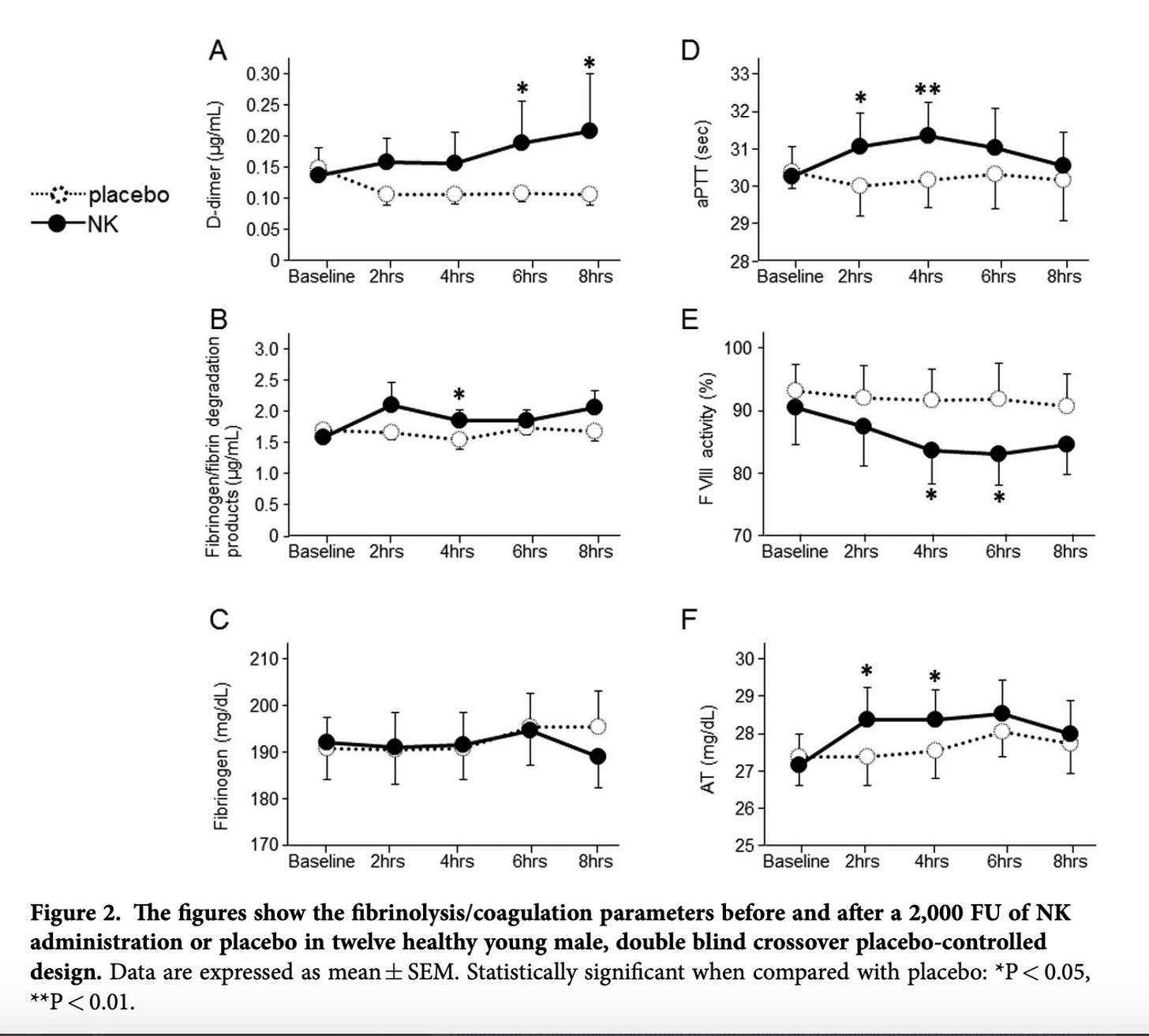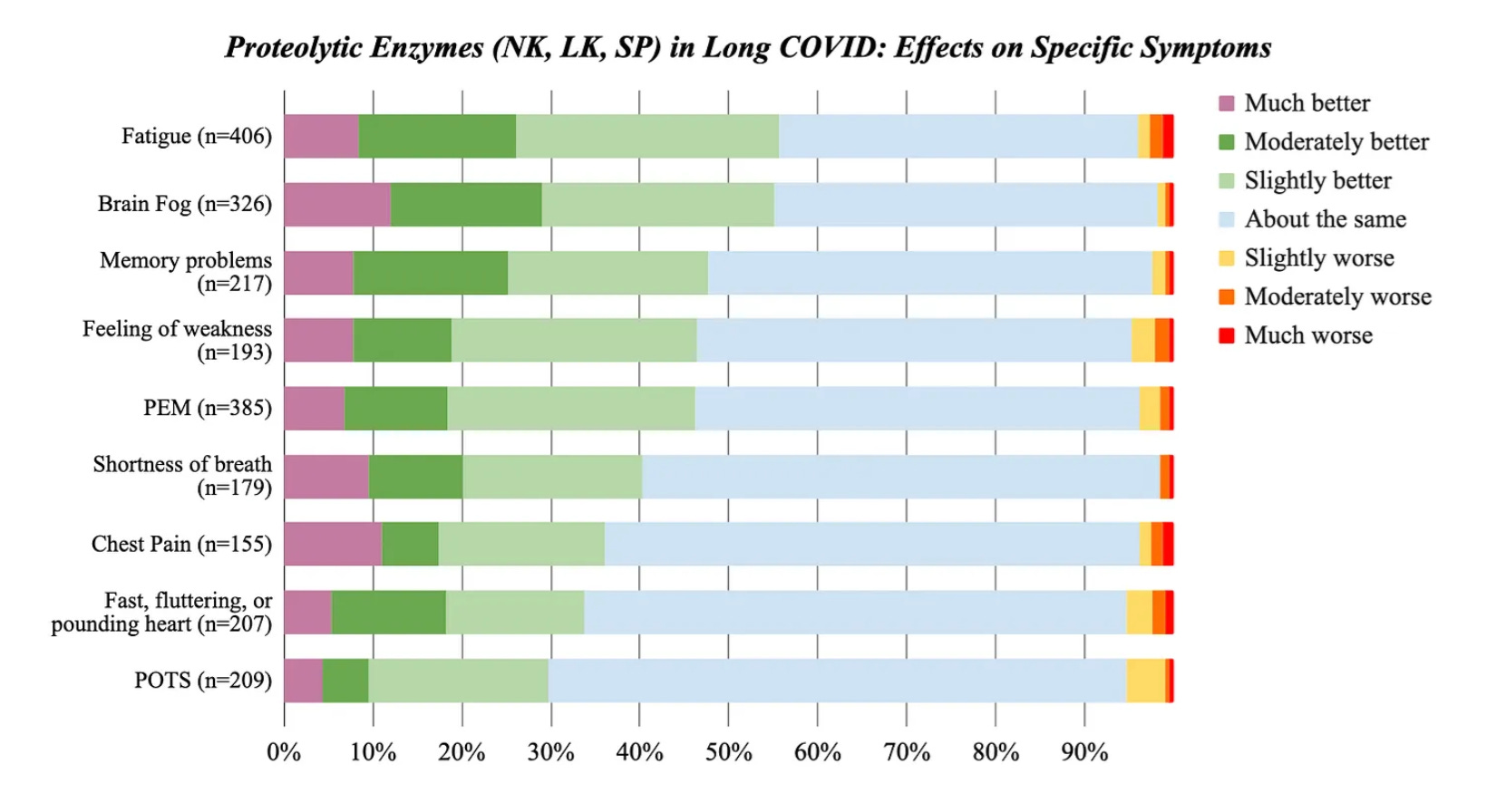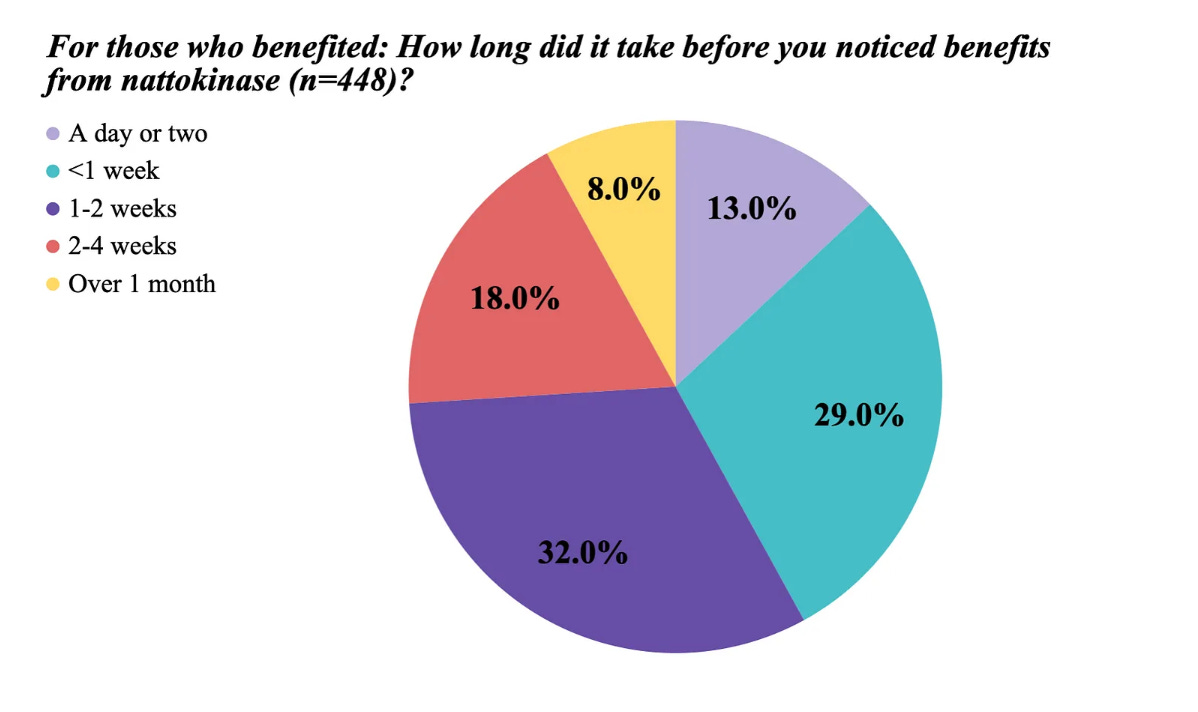Rapid-Fire FAQ: Nattokinase and Lumbrokinase
Please check here for all your questions on these proteolytic enzymes used in Long Covid and ME/CFS!
Proteolytic enzymes nattokinase and lumbrokinase have become popular supplements for Long COVID sufferers, and with good reason: they reportedly benefit over 60% of those who try them! Below I answer the most frequently asked questions on these intriguing enzymes.
Q: What are nattokinase and lumbrokinase used for?
A: In Long Covid and ME/CFS, nattokinase (NK) and lumbrokinase (LK) are often used to 1) break down biofilms, and 2) degrade small blood clots known as “microclots,” thereby improving blood flow.
Break down biofilms: Biofilms represent colonies of bacteria or viruses stuck to each other or another surface. They help microbes hide out & evade the immune system, sometimes leading to chronic inflammation. When proteolytic enzymes break down fibers in a biofilm matrix, this helps the immune system to access and fight off biofilm pathogens more effectively. I discuss biofilms and another proteolytic enzyme called serrapeptase in this thread.
Degrade microclots: Blood clots are primarily comprised of fibrin and platelets. Nattokinase and lumbrokinase break down fibrin—a process known as fibrinolysis—and exhibit mild antiplatelet activity. Recent and past studies have shown that Long COVID and ME/CFS patients may be stuck in a hypercoagulable state; that is, their blood tends to clot too much. Tiny clots known as microclots may form throughout the body, disrupting circulation and causing a host of symptoms such as fatigue, cognitive dysfunction, chest pain, shortness of breath, et al. NK and LK may help relieve some of these symptoms by degrading the fibrin in microclots and calming down hyperactivated platelets.
This double-blind, placebo-controlled crossover study in 12 young & healthy Japanese men found that even a single 2,000 FU dose of nattokinase activated multiple fibrinolytic pathways:
As Graph A illustrates above, the fibrin degradation product known as D-dimer significantly increased 6 to 8 hours post-dose. An increase in D-dimer following NK administration is a good indication of NK’s clot-busting activity. It’s worth noting that the study above involved healthy participants whose D-dimer increased but still remained in the normal range. However, if you are suffering from significant microclotting, it’s plausible that NK or LK may elevate your D-dimer to levels slightly above normal.
Q: I heard that nattokinase breaks down the SARS-CoV-2 spike protein. Is this true?
A: Yes, in vitro, nattokinase does indeed degrade the spike protein. The study linked found that nattokinase degraded the S protein via time-dependent inhibition at concentrations as low as 1 µg/mL (this is promising!). Viral inhibition took place after 60-180 minutes. However, it hasn’t been tested in human trials yet. A major caveat is that nattokinase breaks down other proteins; it is NOT specific to the spike. Thus nattokinase supplementation may demonstrate a small added benefit of degrading some spike protein, but not all or even most.
Q: Which symptoms do these enzymes improve?
A: Per my surveys, these enzymes reportedly help the most with fatigue and brain fog in both ME/CFS and Long COVID. This makes sense considering that impaired blood flow to the brain causes brain fog and poor blood circulation often causes fatigue. Please see more information in the charts below and refer to a detailed analysis of survey data here.
Q: What symptoms are these enzymes LESS likely to help with?
A: The symptoms for which NK and LK appear to be the least beneficial per my surveys—improving in ≤30% of those surveyed—include neuropathy, muscle spasms, muscle/joint pain, tinnitus, gastrointestinal issues, and sense of smell.
Q: What dose of nattokinase should I take?
A: It depends on many factors. Consider your individual medical history, age, and current medications. Most brands are 2,000 FU per capsule; however, my surveys have shown that most people with Long Covid & ME do better on higher doses anywhere from 4000 FU to 12,000 FU total daily dose. The “sweet spot” for many seems to be around 4000 FU twice daily on an empty stomach. Of note, a recent retrospective analysis from 1,062 pts examined safety & efficacy of nattokinase 10,800 FU in the treatment of atherosclerosis progression & hyperlipidemia. Authors did not report any safety issues at this higher dose: “No noticeable adverse effects associated with the use of nattokinase were recorded.”
Generally speaking:
Start at a subtherapeutic dose to assess tolerability (i.e. 2000 FU once daily on empty stomach).
Titrate up dose as tolerated to appropriate dose based on medical history & other medications.
Q: What about my child? Is it safe for kids to take?
A: To my knowledge, there have been no nattokinase efficacy or safety trials in children. Anecdotally, one reputable MD whose teenage child had Long Covid advised me that physicians are starting Long Covid children at half-doses and then titrating up as tolerated. The best low-dose nattokinase I’ve come across are Naturally Vitamins 750 FU and Solaray’s nattokinase 1250 FU, both enteric coated.
Q: Is it safe to take nattokinase with aspirin?
A: More studies are needed in this arena. In this trial, 96 patients with cardiovascular disease took NK 10,800 FU along with aspirin 100 mg once daily over the course of 12 months. Authors found that aspirin with nattokinase showed a synergistic effect, further improving cardiovascular outcomes with no recorded adverse events.
However, keep in mind that aspirin in and of itself DOES increase the risk of bleeding. The cardiovascular benefits of daily aspirin outweigh bleeding risks in a relatively small minority. Specifically, the USPSTF determined that for primary atherosclerotic cardiovascular disease (ASCVD) prevention, daily aspirin has a small net benefit in those aged 40-59 with a ≥10% ten-year risk of ASCVD, but not in those age 60+:
This risk calculator helps practitioners decide if their patients should take daily low-dose aspirin. Unfortunately, the calculator does not consider history of COVID or long COVID which likely skews the risk/benefit ratio, especially considering that some long COVID and post-viral ME/CFS patients appear to have hyperactivated platelets. Before starting daily aspirin — with or without nattokinase — it is important to consult with your health care provider. If your doctor determines aspirin is appropriate for you, the additive risk of bleeding with moderately-dosed nattokinase (or lumbrokinase) is likely negligible for the majority, but it cannot be ruled out. Consider individual history.
Q: There are so many brands of nattokinase. Which brand should I choose?
A: More data are needed to identify what nuances may exist between brands. Below is a table showing patient reports from any brand that received at least 20 responses. Doctor’s Best Nattokinase and Doctor’s Best Natto-Serra (combo) were by far the most commonly used brands (n=205 & n=177, respectively) with an adequate sample size, followed by Solaray’s Nattokinase (n=42) and Solaray’s NK-SP combo (n=27).
Nattokinase brands with enteric coatings performed better per survey participant reports. This is not surprising considering that several studies found NK enzyme activity was reduced in simulated gastric juice, but PRESERVED with enteric coating. Acid-resistant coating should prevent dissolution in the stomach so that NK may be absorbed in the more basic conditions of the intestine:
In short, acid resistant brands likely optimize efficacy. Some of the more promising brands are listed below:
Doctor’s Best Natto-Serra (2000 FU/40,000 SPU)
Solaray’s Nattokinase 3000 FU/Serrapeptase 60,000 FU
For those with soy intolerance/allergy, two soy-free formulations are below:
Sunday Naturally Nattokinase 2000 FU
Healthy Origins Nattokinase 2000 FU
Q: How long does it take to see benefits?
A: It varies, but nearly 75% see benefits within 2 weeks.
Q: Does nattokinase affect menstrual cycle?
A: According to the results of one of my Twitter polls, yes, it may in some cases.
Q: Do I need to take serrapeptase too?
A: That’s less clear. Serrapeptase is an intriguing proteolytic enzyme with a diverse range of activity including improved microcirculation, anti-inflammatory effects & biofilm degradation. Multiple studies suggest serrapeptase supplementation improves antibiotic efficacy. Some report benefits with serrapeptase while others report it is less tolerable compared to nattokinase. Most common reported side effects with serrapeptase are headache and nausea.
Q: If I decide to take serrapeptase, what’s the best dose?
A: Human studies range from 20,000 SPU to 120,000 SPU total daily dose, with smaller doses at more frequent intervals preferred (i.e., 40,000 SPU three times daily on empty stomach). Enteric coating may improve efficacy. Anecdotally, some are taking much higher doses, but this hasn’t been studied.
Q: I did not tolerate nattokinase well and want to try lumbrokinase instead. Can I take lumbrokinase with aspirin?
A: An RCT from 2013 examined secondary stroke prevention with lumbrokinase (n=169) vs placebo (n=105). 169 received full course of LK 600,000 IU three times daily for 1 yr. Over HALF used concomitant anti-platelet drugs for the duration of trial. 1 case of bleeding (GI) was reported. An incipient RCT will examine the efficacy & safety of LK + aspirin versus aspirin alone for acute ischemic stroke. Stay tuned.
Q: What dose of lumbrokinase is best?
A: Like with nattokinase, it varies based on brand, medical history, and medications. Generally speaking, it appears the lumbrokinase formulations studied have a good safety profile at 600,000 IU every 8 hours. Boluoke® has been used in many Chinese trials. Their recommended dosing is also 600,000 IU three times daily. The company attests that its brand does not affect PTT or PT. This means it does not slow down the time it takes the body to form a blood clot, unlike nattokinase. See next question for more details on this topic.
Q: I heard that nattokinase affects blood clotting time and may have anticoagulant activity along with its clot-busting ability. Is this true?
A: Yes, it appears to be true. Several studies have shown that nattokinase increases time to clot (PTT, or Partial Thromboblastin Time) and inhibits at least one & maybe more coagulation factors (factors VIII and maybe VII). This suggests that NK exhibits some anticoagulant activity, so monitor for any signs of bleeding.
Q: Why are you always talking about nattokinase and not lumbrokinase? Isn’t lumbrokinase stronger and better?
A: It is harder to predict efficacy with lumbrokinase for three reasons:
Fewer people have tried LK for Long Covid or ME and thus I don’t have a big enough sample size from surveys to draw as many nuanced conclusions.
Efficacy of lumbrokinase is harder to predict across brands because different brands have different enzyme extractions and thus different fibrinolytic potency. The only brand proven to have “stronger” fibrinolytic potency than nattokinase is Boluoke:
A risk with the higher potency is potentially less tolerability due to Herxheimer reactions. Lumbrokinase comes from earthworms, and multiple different proteases [proteolytic enzymes] can be extracted from several different earthworm species. Each brand may come from different species and/or a different cross-section of proteases ("enzyme fraction").
I hope this FAQ section addressed all of your questions! If not, make sure to check out this article I wrote which includes more details along with relevant survey result analyses. Thank you!















Fascinating piece, thank you. Incredibly useful. This makes me want to stagger using natto, lumbro and aspirin, just to be safer. And I hadn't realised that empty stomach was best either. I'm going to start off with the natto, and increase my dose compared to last time. Thanks again.
Is it possible there might be any benefits to taking nattinokase during the acute phase of infection?
I’ve only heard people talk about it when treating long Covid, but what about as a supplement during initial infection?
Thank you so much!